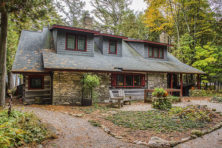Storybook House: The Carey’s cozy cabin on Chapel Lane
- Share
- Tweet
- Pin
- Share

When Deb and Dan Carey began designing their second home in Baileys Harbor, they weren’t focused on space. They bucked the HGTV trends that dot the peninsula’s fields and shorelines – there’s nothing “modern farmhouse” about it.
“We wanted it cozy, warm, inviting,” Deb said. “And we wanted it to fit in with this street. I wanted it to look like it belonged here.”
That street is Chapel Lane, a short stretch of rustic road south of Baileys Harbor lined with historical log cabins, a canopy of trees, and a touch of fairytale. Dan said they aimed to make the home feel whimsical and Old World, much like the village of New Glarus, home to the famous brewery they founded in 1993.

And it does. Deb calls it “my storybook home” for good reason. From the outside, it resembles a gingerbread house – a cabin straight out of a children’s fairytale – with a small turret entryway as a touch of castle.
The three-bedroom home on the rocky shores south of Baileys Harbor encompasses a bit more than 1,800 square feet.
“The idea of having thousands of square feet to heat and clean didn’t appeal to us,” Deb said. “We were thinking of retirement when we built it.”
When envisioning the exterior, Deb was inspired by the buildings of Peninsula State Park, choosing wide planks of live-edge pine from central Wisconsin.
“Woodpeckers eat cedar, not pine,” she said.

A stained-glass window featuring a cherub is installed above the doors to a small, secret room off the kitchen. Photo by Len Villano. 
A painting in progress rests on an easel in Deb Carey’s studio. Photo by Len Villano.
Inside, the rooms are small, with arched doorways and Old World touches such as the stained-glass window in the dining room and the Swedish stove, or kakelugn, that efficiently distributes radiant heat into the small living room, which has windows looking out on Lake Michigan.
The one small “extra” in the home is a small room off the garage, where Deb continues her pursuit of her original passion. Here Deb – the artist behind the beer labels of New Glarus Brewing Co. – continues to paint, with a portrait in progress resting on an easel during our tour.
Twelve years after moving in, she has no regrets.
“We love it here,” she said.
The Kakelugn

The Swedish stove, or kakelugn, is the centerpiece of the living room. A craftsman and his daughter were flown in from Sweden to build the stove in traditional Swedish style.
For centuries, Nordic countries relied on wood as the primary fuel for heat, but by the 1700s, the nation’s forests were being depleted. In 1776, Sweden’s King Adolf Frederick commissioned Carl Johan Cronstedt to develop a more efficient stove.
The result was a tiled Swedish stove, which burns wood more slowly and radiates heat for hours, even after the fire burns out. The tile exterior hides a distinctive construction of brick channels that guide heat up and down the stove, slowing its path out the chimney and providing warmth for up to 12 hours.

